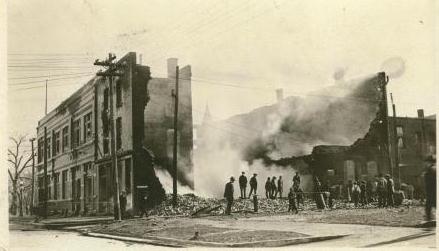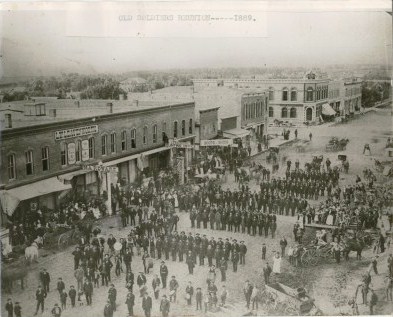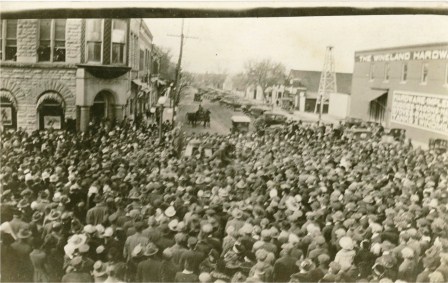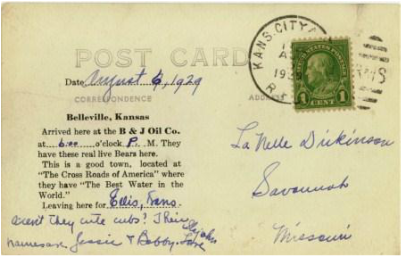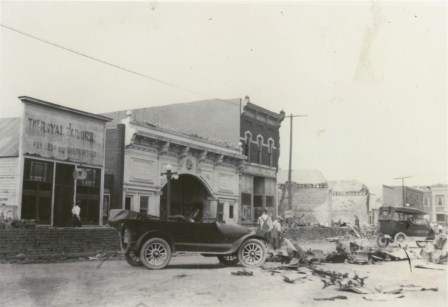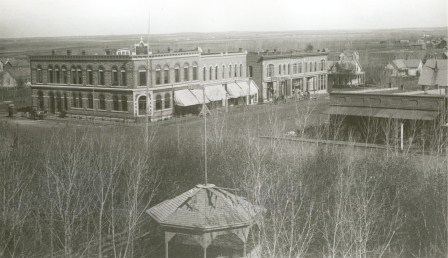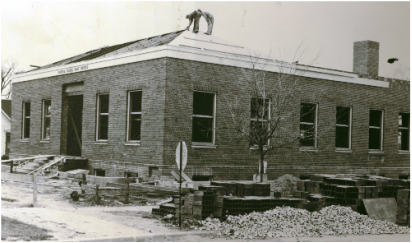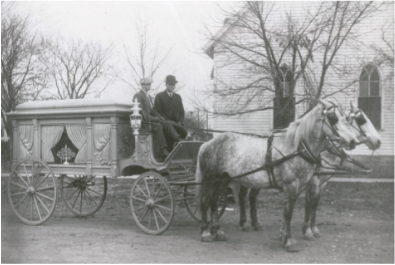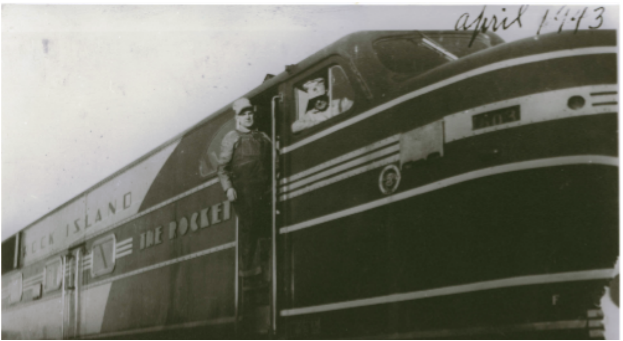Belleville Kansas township was incorporated on September 25, 1869 (City incorporated January 10, 1878) and was named Belleville in honor of founding father A.B. Tutton’s wife, Arabelle. Belleville was designated the Republic County seat and now houses the impressive art deco Republic County Courthouse which was built after the original Courthouse burned down. The first erected building was on the north side of the public square was the Belleville hotel. The front part of the building housed an office, parlor, confectionery store, cigar store and washroom. The upper story was used for six sleeping apartments, a bridal chamber, and staff housing. In 1870, other substantial business buildings were built including a general store on the southwest corner of the square, drug/grocery store, general store, and a hotel on the north side of the square. Also during 1870, The Belleville Telescope was started with the first issue coming on on September 20th. The paper still operates today.
Belleville is located in the center of Republic County and was the junction of two divisions of the great Rock Island railway system. Information courtesy of History of Republic County Kansas Belleville is also at the intersection of two major highways, U.S. Highway 36 and four-lane U.S. Highway 81, both contributing to the City being called The Crossroads of America for nearly a century and making Belleville the ideal place for businesses.
The City of Belleville is also known for it’s racing history at the historic 1910 era Belleville Highbanks Racetrack, which is the “World’s Fastest Half Mile Dirt Track”, and the Belleville Midget Nationals. In 2004, the High Banks Hall of Fame and National Midget Auto Racing Museum was started to help preserve all of Belleville’s racing history. Belleville also has many other great attractions including the Boyer Museum (a museum which houses amazing animated carvings), The Republic County Historical Society Museum, Rocky Pond and awesome art deco architecture throughout town.
Belleville is located in the center of Republic County and was the junction of two divisions of the great Rock Island railway system. Information courtesy of History of Republic County Kansas Belleville is also at the intersection of two major highways, U.S. Highway 36 and four-lane U.S. Highway 81, both contributing to the City being called The Crossroads of America for nearly a century and making Belleville the ideal place for businesses.
The City of Belleville is also known for it’s racing history at the historic 1910 era Belleville Highbanks Racetrack, which is the “World’s Fastest Half Mile Dirt Track”, and the Belleville Midget Nationals. In 2004, the High Banks Hall of Fame and National Midget Auto Racing Museum was started to help preserve all of Belleville’s racing history. Belleville also has many other great attractions including the Boyer Museum (a museum which houses amazing animated carvings), The Republic County Historical Society Museum, Rocky Pond and awesome art deco architecture throughout town.
|
1802 M Street: On this important corner in Belleville’s early history, the first brick building in town, constructed by Volney Van Trump in 1882, stood on this site. Van Trump leased the second floor to the IOOF and the AF & AM Lodges. Van Trump had the post office in the rear of the building and, later, rented the first floor to the First State Bank. Judge J.C. Hogin bought the existing building in 1912 and built a new one in 1916. The Belleville State Bank, established on August 8, 1900, occupied the first floor of the new building until it merged with the People’s National Bank in 1931. This location has also housed Lowes Bookstore, Kesl Jewelry, Belleville Electronics and Navis Law Office. |
After this building was constructed, its simple Commercial style was repeated in the brick masonry features of the adjoining buildings at 1804 and 1806 M Street. The architectural style was articulated in the ornamental pier caps, ornamental brick paneling, the smooth-cut belt course below the first floor north and second floor windows, recessed and stepped brick panels, raised brick belt courses, and soldier courses at the eave. There is a smooth-cut stone parapet cap.
1804 M St: At this
location, Ezra Powell built the Powell Opera House which had a grand opening on
December 22, 1887. The second floor
opera house had a seating capacity of 700 with seats that could be removed so
the room could be used as a ballroom.
Powell died about 1896 and the building was sold to Armstrong and
Company. A spectacular fire on February 14, 1924 destroyed
the Opera House, the Opera House Café, and the Arbuthnot Drug Company. Damage was estimated between $60,000 and
$75,000. Later, W.A. Hollandsworth built a new business block on
the property that had an ell plan arranged “around the State
Bank Building”
(1802 M St.) in 1938-39. (picture shows the opera house from the back)
|
“For years, we sold
school books and that was a nightmare.
Everybody bought their own books and I remember going into fair week
people would be lined up waiting to go up the balcony steps to buy those books,
and it was a nightmare. Well, I’d almost
forgotten about the school books.” Melissa
Arbuthnot
|
1806 M St.: Godard’s Drug Store est. ca. 1880
was located at this location. C.M.
Arbuthnot joined the business in 1886.
In 1897, Armstrong & Co. bought the drug store. Dr. Arbuthnot bought the business in 1914 and
his three sons Charles, Fred, and Sydney joined the business. Sydney sold
his interest to Fred in 1924 and Fred sold to Fred M. Colwell in 1927 and moved
to California. Then, Sydney
returned to Belleville
and purchased the Republic Pharmacy from Mrs. P.E. Tyler. In 1946, the Arbuthnot Drug store moved to
1806 M Street, a property still owned by the Arbuthnot family. James Arbuthnot joined his father, Sydney, in
1950 and Sydney
owned the business until January 1963.
Later, Bob Arbuthnot joined his father James in 1976 to make four
generations of Arbuthnot pharmacists. In
1968, Arbuthnot Drug Company purchased the Hollandsworth building formerly
occupied by Crane Hardware (1804 M Street).
In an extensive remodeling, the drug company more than doubled the size
of the original building.
“I remember on Sunday
afternoon we moved out of the front door of 1820 Main Street and they (Colwell
Drug) moved out the back door, and we switched buildings” Melissa Arbuthnot
|
1816-1820-1822 M
Street.These
buildings were constructed after a large fire in February, 1884 which consumed
two hundred feet of wood frame commercial buildings at this location. The
buildings have native stone walls with brick fronts. These are some of Belleville’s earliest commercial buildings
with well-preserved storefronts. Typical
of nineteenth century architecture, the storefronts are composed of bulkheads,
large display windows, and transoms with a storefront lintel supported on
ornamental cast iron posts. On the
second floor, the windows have smooth-cut stone sills and segmental
arches. The arches are characteristic of
the Italianate style applied to commercial buildings and the eave is ornamented
with raised brick belt courses and a slightly projected brick cornice.
|
1834 M St: In 1900 Hostetler Brothers purchased two small wood frame buildings on the lots north of their main store and built a one-story brick building as an annex selling shoes, women's and men's clothing. The building has been occupied as a fabric store for many years, in most recent years housing Sew Country, a specialty Quilt Shop. Sheila Cornett, the building owner, completed a façade renovation in 2003. |
|
1836 M St: Belleville's first store opened on this site on July 4, 1870 in a small wood frame building constructed by Dr. J. C. Griffith with his partner James Tuthill. James McCullough built the present brick building in 1892 and sold the second floor to the Masonic Lodge No. 129 A.F. & A.M. for its meeting hall. The Democrat, a weekly newspaper, was published in the basement at this time. The first floor was occupied by Hostetler Brothers & Casper, selling general merchandise and groceries. Later Edmund Carstensen joined the firm until 1914. This was the Eller's store in the mid-twentieth century. Corner buildings on commercial streets were often larger and more prominent. This building and the former People’s National Bank to the south are examples of this custom. The McCullough Building has elaborate brick masonry detailing characteristic of the Romanesque style. The round-arched masonry openings, raised brick pilasters, stepped brick belt courses and recessed brick eave panels are features of this style. Like many nineteenth century Belleville buildings, the rear and side walls that are less visible are constructed of native stone. |
If I had to pick a
favorite it was the Eller’s Store on the southwest corner of the square. When I was a boy you’d go in there and buy a
pound of peanut butter, there was a big barrel there open, they dipped it in
and put it in one those little wood containers.
If you wanted a few bananas there was a great big, I don’t know what you
call them hanging there, and they’d just go, take a sharp knife, and cut off
that many bananas. And you’d buy your
shoes, buy your shirt and overalls there.
Women could buy their dress material.
I just don’t know of much of anything but what you could buy it at
Eller’s.
Ralph Walter
Ralph Walter
|
1914 M St: J. A.
Mosher acquired most of the east half of this block in the early 1880s. He built a large brick garage on the corner
in 1916 which he operated for some time with John Reed. Leslie Lair with his partner, Fenton Weeks,
moved in about 1929. The state port of
entry was established in Belleville
in 1933 and was first located in this building.
O. B. and Orren Lewis bought the garage and business in 1948. The Food Mart was located here from 1958 to
1967. Tibbetts-Fischer Furniture took
over in 1967. Although still owned by
Tibbetts Bros. Inc., the name of the business was changed to The Feathered Nest
in 2007.
This is
a well preserved example of the Commercial style. In the main east front, there are large
display windows. The brick façade is
ornamented with smooth-cut stone pier caps, a belt course, eave ornament, and a
parapet cap.
|
1306 19thSt:
This was the site of the Hardy
Block, a group of five stores facing west.
In 1916 owner C. P. Carstensen erected a new building on the
corner. The west storeroom was occupied
by the Belleville Post Office from 1917 to ca.1938. Then the building was used by the A. L.
Duckwall, Safeway, and Gambles stores, MC Outlet, and Belleville Bowl started
business there in 1994. The Democrat
Newspaper ran their business on the West side of this building at one time.
|
1312 19th St: When Sam H. Blair opened the Blair Theater in 1928, it was called "one of the finest in northern Kansas and southern Nebraska." Sam and Katie Blair came to Belleville from Mena, Arkansas, in 1920 when they heard that the local theater was for sale. When their lease on the Chapin building ended in 1928, they decided to build an up-to-date moving picture theater. The Blairs purchased three buildings on the south side of the square and rebuilt them into a tall brick building with a Spanish ornamental façade. The Pearcy brothers, Glenn, Fred, and George, built the building which cost $35,000. The Blair Theater opened on December 24, 1928 and talking pictures came to Belleville on April 19, 1929. In 1941 the Blairs leased the theater to the Commonwealth theater chain and sold the building to Commonwealth in 1966. The Blair Theater re-opened in 2008 through the gallant efforts of the Blair Center for the Arts, a non-profit organization.
One of the most distinctive buildings in downtown Belleville, the Blair Theater is a well preserved example of the Spanish Eclectic style applied to a motion picture theater. The elaborate marquee is a prominent feature, and the vertical marquee is surrounded by a multi-colored terra cotta panel. Other vertical terra cotta insets ornament the brick façade. There are mock gable roofs covered with tiles at the eave and a prominent central shaped parapet with circular piercing. |
|
“Sam and Katie were remarkable people. They did a lot for the Blair Theater, and for the whole community.” Melissa Arbuthnot
|
“..some days they’d have free movies. Well, they weren’t movies, they were still pictures and Maude Greg played the piano through all of it. She’d just sit there and play the piano and that was our noise. I mean that, besides the kids.” Verna Willis
|
“…Maude Greg used to play the piano all the time. And as the show, or the movement of the show was going on, then the faster she would play. And then really go fast a lot with the horses.” Mable Whitney
|
|
1322 – 1324 - 1326 19th St. This building survived a major fire on July 28,1919, that destroyed four brick store buildings to the west. In the early twentieth century, the building, owned by G. A. Chapin, was used for the Electrodome Theater. . The building also has housed Barth Appliance which moved to this location in January 1970. Most recently, this building serves as Bachelor Faulkner Dart Surber Funeral Chapel (2009).
As you can observe from the picture this was once a grand building. Although the storefront has been covered, the elaborate Italianate pressed metal cornice remains with ornamental brackets, a corner urn, and a lion’s head plaque in the center of the upper façade. |
Do you remember going to the theater? “Yeah, we went. It’s not where it is now. It was over east and it had the big lion head above it. And I think it cost 10 cents. We couldn’t go, for us kids...We couldn’t go too often because we didn’t have the 10 cents. Verna Willis
|
As a direct expression of function and form with its banks of windows, intersecting masses, and roof forms, the Belleville Library represented a variation of the modern style that rejected architecture based on historical precedents. Unlike most of the historical building constructed around the town square, this Contemporary style building incorporates the intersecting shed roof forms that were innovative for the period.
|
Belleville Public Library: A public library for Belleville was first discussed in 1924. In 1926, representatives of nineteen community organizations and churches began seeking donations of books and money. The rooms of Mr. Clark Perry on the west side of the square were rented for $10/month to house the library. During the 30s, the library was moved several times as it continued to grow. It was located on the east side of the square, upstairs in the Bush building, then downstairs in the Belleville Building & Loan Building and finally moved to the Chappius house at 1924 L Street. The present building was completed in 1956 on the site of the former Republic County Jail. An addition was completed in 1983 and another major remodeling occurred in 1998. Thanks to grant funding through the Kansas Humanities Council and generous local donors, a wonderful collection of vintage WPA handicrafts is available to the public. The library’s collection includes 17 pairs of costume dolls, 43 prints of Kansas landmarks by Margaret Whittemore, 5 paintings of Kansas wildflowers by Avis Chitwood, 6 intricate wooden models, and one horn carving.
|
|
1825 N St: This building dates to 1886 and housed F.N Bush & Son General Merchandise. The storefront was remodeled in the 1930’s. The Paul Fahrbach Market was located here in the 1960’s and 70’s. More recent businesses have been Country General and Belleville Farm & Home.
“On the east side of the square there was one (grocery store), Paul’s Market, which was a real nice place, especially for the kids. They still had rows of cookies and candy and so on where you went and picked out 1 or 2 pieces of candy.” Frank Barth |
|
1313 18th St: On this site once stood Hasketts Livery Stable in 1874 and the "Rex" moving picture house. The current building was built in 1920 by F. W. Simmons who sold Buicks and was the location for Charles Blosser Garage later in the 1920's. Russell Johnson Hardware; Bachelor Implement - International Harvester and Mike's Body Shop. Similar to the Mosher Garage at 1914 M, this building is an example of the Commercial style. The store front bays, overhead transoms, recessed brick panels with stone corner ornaments and brick soldier courses and parapet cap are well reserved.
|
1305 18th St: This building was owned by and was the office of I.O Savage in 1876. I.O. Savage was a prominent historian that recorded Republic County History from the first settlement to 1901. Savage was also the topographer for the county and a statistician. Dr. W.H. Woodward had an office in this building in 1881. The J. Walker Barber Shop was housed here and C.A. McMullen operated a pool hall & soft drink parlor here until 1944. More recently the building has housed Hair Plus. John & Sondra Richardson completed a façade renovation in 2005.
|
|
1718 ~ 1720 M St.: The First National Bank Block was built in 1893. The two-story stone building once had a
projecting circular second-floor bay with a distinctive domed roof that called
attention to this prominent corner building.
After coming to Belleville, the First
National Bank of Scandia changed its name to National Bank of Belleville and moved into this building ca.
1894. An earlier brick bank building was
built on this site in 1884, but burned in 1892 and was recorded as “ruins” in
the February 1893 Sanborn Map.
The Post Office was located in the rear of this building from about 1906 to 1916. Directors changed the name again in 1921 to the First National Bank in Belleville. The second floor bay was removed about 1950 "in keeping with the rest of the town's modernization." The bank moved out of this building into a new modern structure in 1965. |
There
was a barber shop located in the basement at one time. The mosaic tile floor and shower stalls still
remain. In recent years, a partition wall
was removed and this building was joined with 1716 M Street. It has also housed Coast to Coast, Grover’s
Do it Best and the Belleville Farm & Home Hardware stores.
Constructed on rough-cut native stone coursed blocks, this building is an example of the Richardsonian Romanesque style. The corner entrance, round-arched masonry openings, rough-cut sills, and massive flat lintels are characteristic features of this style. The eave has been covered with non-historic material.
“…there was a barber shop in the basement and I had a lot of (fun), I used to go down there, run errands for a penny or a nickel. Someone would give me a nickel to go and get an ice cream cone with. I hung out down there a lot. My mother, whenever she wanted me, why she knew where I was, begging, begging money in there. And uh, then they used to have a tile floor and they draw a line, I remember I would stand on the line and then they would pitch, and whoever got the closest the barber or the customer got the closest, why they got a free haircut or they double one or the other. I remember my dad and many of them sitting down there under a hair growing machine, was a, looked like a metal cap from outer space; put on their head sit there for a half hour, have a ring of heat and everything, supposed to grow hair, but it never grew hair.” Jack Collins
Constructed on rough-cut native stone coursed blocks, this building is an example of the Richardsonian Romanesque style. The corner entrance, round-arched masonry openings, rough-cut sills, and massive flat lintels are characteristic features of this style. The eave has been covered with non-historic material.
“…there was a barber shop in the basement and I had a lot of (fun), I used to go down there, run errands for a penny or a nickel. Someone would give me a nickel to go and get an ice cream cone with. I hung out down there a lot. My mother, whenever she wanted me, why she knew where I was, begging, begging money in there. And uh, then they used to have a tile floor and they draw a line, I remember I would stand on the line and then they would pitch, and whoever got the closest the barber or the customer got the closest, why they got a free haircut or they double one or the other. I remember my dad and many of them sitting down there under a hair growing machine, was a, looked like a metal cap from outer space; put on their head sit there for a half hour, have a ring of heat and everything, supposed to grow hair, but it never grew hair.” Jack Collins
|
This is the site of the Cash Store Mercantile
established in 1899 by W.A. Hollingsworth and A. H. Loomis. That building was destroyed by fire on September 24, 1904 and the
replacement was ready for occupancy about February 1, 1906. Sometime in the 1920’s, Hollandsworth annexed
the adjoining store which had been occupied by the Republic Pharmacy. In this storefront, Mrs. Hollandsworth
operated a millinery and ladies ready to wear department. The store was known as the “Austin-Hollandsworth
Mercantile” Store until 1932. Mr.
Hollingsworth retired in 1942.
JC Penney’s opened in Belleville in 1932 and moved to the former Hollandsworth Mercantile building in 1946. Penney’s occupied the storefront as late as 1976. Other businesses have been a second hand store and Crossroads Floral & Antique Villa. |
The
brick façade is typical of early twentieth century commercial
architecture. On the second floor, the
windows have smooth-cut stone sills and flat lintels. The eave is ornamented with molded brick belt
courses and a corbelled brick eave course surmounted by a smooth-cut stone
parapet cap.
“The [store] that fascinated me was Hollandsworth. To this day I see an old movie or something where they had them tracks, you know the bookkeeper was sitting up there. They’d take that bill put it in there and turn a wheel and pull. That thing would go flying up there to her. They had stuff stacked up clear to the roof and they had a big ladder that slid along a rail and they’d climb up there some, but they also had a big stick with a hook on it. Like for a pair of shoes they’d try to size up for a pair of shoes, reach up with that hook and catch it as it was coming down.” Ralph Walter
“The [store] that fascinated me was Hollandsworth. To this day I see an old movie or something where they had them tracks, you know the bookkeeper was sitting up there. They’d take that bill put it in there and turn a wheel and pull. That thing would go flying up there to her. They had stuff stacked up clear to the roof and they had a big ladder that slid along a rail and they’d climb up there some, but they also had a big stick with a hook on it. Like for a pair of shoes they’d try to size up for a pair of shoes, reach up with that hook and catch it as it was coming down.” Ralph Walter
Built in 1885, the Hotel
Republic is a local landmark that
occupied part of the Republic Block, one of the earliest surviving buildings in
downtown Belleville. Thomas P. Phillips, a Chicago
capitalist, commissioned the building and brought S. L. Palmer to Belleville to manage the
hotel. Charles Bell, supervising
architect for the U. S. Treasury, and the brother of local resident W. H. Bell,
designed the Republic Block. The Hotel Republic
served the community for many years and sheltered railroad passengers first and
then auto travelers. Henry Collins
purchased the building from John M. Doyle in January, 1914. His son Percy and his wife Ola took over
management of the hotel in 1919 and the Collins family lived in the hotel. Their sons, Percy, Jr. and Jack Collins
inherited the property.
When the Republic Block was built in 1885, the lower level was built to house retail shops and local businesses still occupy that space today. The north portion of the lower level was the Annex Café for many years. The Republic Block is an example of the Italianate style, the most popular style for commercial buildings during this period. The hotel office was indicated by a corner entrance surmounted by a triangular pedimented cornice at the eave. The pressed metal cornice ornamented the full length of the Republic Block. Second floor windows in the main façade also have Italianate round-arched openings accentuated by smooth-cut stone ornamentation.
“Everett & I had our wedding supper at the Annex Café it cost a dollar and a half. We had T-Bone steaks and everything that goes with it and cherry pie for a dollar and a half” Verna Willis
When the Republic Block was built in 1885, the lower level was built to house retail shops and local businesses still occupy that space today. The north portion of the lower level was the Annex Café for many years. The Republic Block is an example of the Italianate style, the most popular style for commercial buildings during this period. The hotel office was indicated by a corner entrance surmounted by a triangular pedimented cornice at the eave. The pressed metal cornice ornamented the full length of the Republic Block. Second floor windows in the main façade also have Italianate round-arched openings accentuated by smooth-cut stone ornamentation.
“Everett & I had our wedding supper at the Annex Café it cost a dollar and a half. We had T-Bone steaks and everything that goes with it and cherry pie for a dollar and a half” Verna Willis
The
present Art Deco style Republic County Courthouse is the third courthouse
building in Belleville
and the second constructed on the public square. According to I. O. Savage, the first
courthouse was a two-story building, 24 X 50 feet, located on the north side of
the square. The first courthouse in the square was finished in 1885. It burned on April 1, 1938.
As the county grew and prospered, a more substantial brick and stone courthouse, designed by George Ropes, architect, and built by contractors, Hulse and Moses and Ulrich Brothers, was completed in December, 1885. This courthouse burned on April 1, 1938. The Public Works Administration, a New Deal program, awarded a grant for forty-five percent of the construction cost (total $250,000). The architectural firm of Mann & Company, Hutchinson, Kansas, designed the new building and Lawrence Peterson Construction served as the general contractor. The completed building was dedicated on December 18, 1939. The Republic County Courthouse was listed on the National Register of Historic Places in 2002 and is a rare example of Art Deco style county courthouses in the state. It is significant for the well-preserved exterior and the original interior plan and hierarchy of space. Supporting functions are located on the ground floor, main offices on the first floor, courtroom on the second floor, and the county jail on the third floor.
The main features of the Art Deco style are the continuous vertical window and entrance bays contrasting with the smooth monolithic concrete walls. Multi-paned windows and the letters in an upper horizontal name panel provide some ornamentation on a building most prominent for its stark geometric massing.
Courthouse lawn activities: “The one I remember most was the end of World War One. My oldest brother and I were in grade school. The message went out over the telephone line that the war had ended and so both my parents gathered up food for a lunch and stopped and got my brother and I from grade school and came to town to celebrate. We had to spread a blanket on the courthouse yard and that was where we, that was our table for our dinner.” Anthony Seaman
As the county grew and prospered, a more substantial brick and stone courthouse, designed by George Ropes, architect, and built by contractors, Hulse and Moses and Ulrich Brothers, was completed in December, 1885. This courthouse burned on April 1, 1938. The Public Works Administration, a New Deal program, awarded a grant for forty-five percent of the construction cost (total $250,000). The architectural firm of Mann & Company, Hutchinson, Kansas, designed the new building and Lawrence Peterson Construction served as the general contractor. The completed building was dedicated on December 18, 1939. The Republic County Courthouse was listed on the National Register of Historic Places in 2002 and is a rare example of Art Deco style county courthouses in the state. It is significant for the well-preserved exterior and the original interior plan and hierarchy of space. Supporting functions are located on the ground floor, main offices on the first floor, courtroom on the second floor, and the county jail on the third floor.
The main features of the Art Deco style are the continuous vertical window and entrance bays contrasting with the smooth monolithic concrete walls. Multi-paned windows and the letters in an upper horizontal name panel provide some ornamentation on a building most prominent for its stark geometric massing.
Courthouse lawn activities: “The one I remember most was the end of World War One. My oldest brother and I were in grade school. The message went out over the telephone line that the war had ended and so both my parents gathered up food for a lunch and stopped and got my brother and I from grade school and came to town to celebrate. We had to spread a blanket on the courthouse yard and that was where we, that was our table for our dinner.” Anthony Seaman
|
From the establishment of the town, the Belleville Post Office was located in several locations around the town square until this building was constructed as a permanent home during the Depression of the 1930s. Construction was supported by a major grant from the Public Works Administration. The building was dedicated October 8, 1938. It is listed on the National Register of Historic Places. Installed above the Postmaster’s door is a Birger Sandzen mural Kansas Stream. The Post Office is a well preserved example of the Colonial Revival style applied to a public building. The entrance framed with molded pilasters and surmounted by a molded frieze, the broad eave cornice, and the 12/8 windows are characteristic features of this style. |
|
1815 L St: The Belleville Telephone Company was organized in 1898
with J. M. Doyle, president, and H. L. Pierce, manager. At first, the company had a switchboard with
a maximum of 100 numbers. The United Telephone
Company bought Belleville Telephone in 1912 and the Farmers' Telephone Company
in 1919.
United Telephone built a handsome two-story brick telephone exchange building on L Street in 1923. Southwest Bell Telephone Company took over the service on January 1, 1938, and the company moved to a modern building in 1964. For many years this building served as the office for the City of Belleville. There are contemporary additions to the north and south. As of 2009, The Republic County Economic Development Office is located in this building. |
The former telephone exchange is a well preserved example of the Classical Revival style. It has an entrance ornamented by sidelights and surmounted by a projecting pedimented molding. Both round-arched and flat-arched masonry openings are distinguished by keystones. There are ornamental projecting cornices above the entrance and at the eave which also has ornamental recessed brick detailing.



